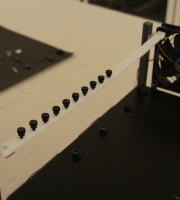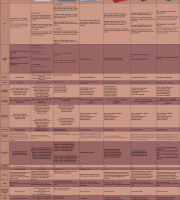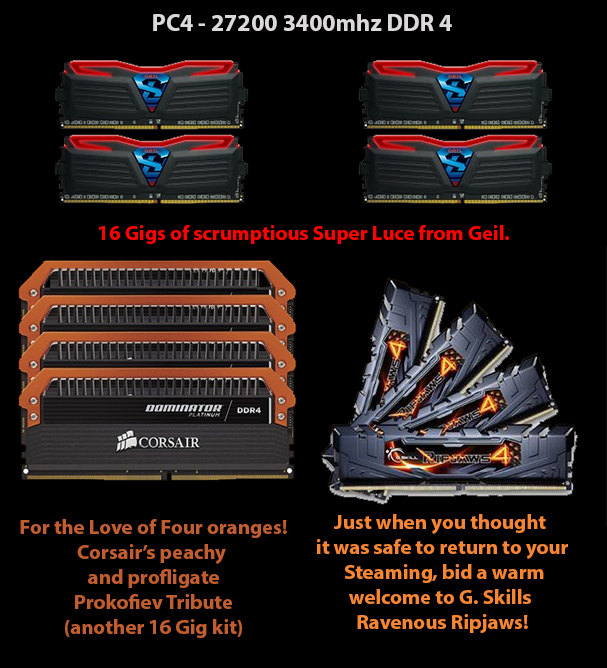


Amidst the hype, drama and fallout of the most publicised cyber showdown since the day Darth Vader gate-crashed Megaton’s Private pool party, the skilful scheming of another equally formidable force silently eluded our senses.
Few would relish the chance to trade teraflops with giant green eyes, or rile Red Beard’s rabid ROPs and yet, whilst this particular sage of semiconductor sorcery could scarcely claim to have paralleled the his foes’ polygonal prowess, the artistic attributes of Intel’s post Haswellian architecture revealed enough sky blue to paint lake superior with a broad brush and a healthy glow.
Of what do we so cryptically speak? Why, a tick-tock fleeter than that of the Falcon’s Fitbit, which of course can’t tick or tock for toffee because it has no moving parts. How about a Gazell’s Garmin? No? An antelope’s Apple Watch? A racing pigeon’s Pebble? Curses, not a cog, pendulum or second hand in earshot. And all I desired was to quaintly inform jaded jargon junkies that yet another glittering gamut of solder and circuitry stood poised cripple their credit ratings.
Got it! A tick tock fleeter than the Road Runner’s Rolex when pursued by Wily Coyote in a propane powered dragster!
Now, let us dispense with laborious linguistics and indulge in a slew of stimulating statistics.
August 2015 witnessed the dawn and noon of Intel’s 14 nanometre era, with the silicone savant’s die shave and swap routine resuming in fine form, and as has been customary since savage sandstorms nullified the Nehalem’s noble reign, it was his heaving hoards of pampered main-streamers whose needs were afforded propriety.
First to materialise was Billy Broadwell, Henry Haswell’s eco-conscious cousin and a chip that trickled onto the mobile market accompanied by such a muted fanfare that many, myself included, had speculated whether its delayed desktop counterparts would ever savour a streak of sunlight or bask in the neon peppered blackness of a gamer’s bespoke pride and joy.
Originally scheduled to escort the Z-97 refresh a year earlier, the Broadwell Brothehood numbered five members, each four cores strong, while hyper threading remained the privilege of its two i7 flagships. Of this quintet, three parts were socket-less BGA affairs and two standard models, branded 5675C and 5775C, were clocked at 3.1 and 3.3ghz by default, with respective “turbo” tempos of 3.6 and 3.7ghz.
The CPUs slotted snugly into the same 1150 pin socket as their 22nm forerunners and cut an attractive package to tardy investors in the Z-97 platform as well as a less extravagant, more overclock-able upgrade to a small portion of existing adopters.
Though unable to displace the infernal Devil’s Canyon, this unheralded processor’s mobile variants commanded comprehensive acclaim from owners of such luxurious portability as MSI’s GT72-Dominator-Pro-G, owing to their leaner power envelope, superior efficiency and ability to maintain their enhanced frequencies with every core fully engaged. In addition, the chip’s “Iris Pro” 6200 hauled integrated graphics technology to unprecedented heights, habitually humbling the efforts of AMD’s fastest APU’s by between 50% and 100% and on occasion, tripling the performance of its elder’s HD 4600.
Curiously, this pictorial party piece handed the Broadwell a recreational advantage over its successor, which emerged from the foundry a mere two months later. However, it wasn’t long before every sagacious source of techno babble was declaring that Intel’s dark, brooding dedication had finally surmounted the challenges posed by this slim and stubborn node and that the spoils afforded by Skylake had far more to do with the copious practicalities of the Z170 chipset than its 91 watt pilot’s modest graphical credentials.
In a bizarre departure from normality, Intel declined to divulge its design’s intricate details at launch, robbing garrulous statisticians of the chance to spend three miles of column inches attempting to explain how and why it was so special, or compose their traditional tributary to teeming transistors. Nevertheless, these all too familiar feats of cubism revealed enough to justify my never revisiting this aggravating article to amend and append.
If the Z-97 had been a bountiful brass band blaring out Brahms’s 5th Hungarian dance, Skylake doubled the tubas, tripled the trumpets and added twenty trombones for a spectacular coda.
The latter is of course a metaphor for the most significant augmentation on a mainstream platform since the introduction of the protocol from which it evolved..
A titillating total of 26 high speed I/O ports served the chipset exclusively, 20 of which were designated as tertiary generation PCI Express lanes, with all linked directly to a ground breaking controller hub, aptly entitled “sunny point”.
The basic configuration allocated 6 fixed lanes to USB 3.0 ports, thereafter, a broad range of resource profiles were assignable at the manufacturer’s discretion, with ample accommodation for a variety of contemporary supplements including USB 3.1, which most elected to implement via Asmedia’s ASM1142 controller, a two lane solution reaching the interface’s maximum of 10 gigabits per second, the same as Sata Express.
One alternative was Intel’s “Alpine ridge”, a propriety solution initially in short supply and readily employed by Gigabyte, who aggressively marketed it as a higher quality and more versatile method of integration. The Chip provided a bandwidth ceiling of 40 gigabits per second and transmitted Thunderbolt 3, USB 3.1, Displayport 1.2 and 10 Gig Ethernet over USB’s reversible “type” C” connector.
The remaining 18 lanes could then be apportioned to such bare essentials as SATA and integrated Ethernet controllers, as well as a trio of “PCIe” storage peripherals, 4 channels a piece and each assignable as a RAID device. For the first time ever, this allowed solidified stalwarts to create boot-able arrays incorporating SATA Express and M.2 drives at BIOS level and in the case of certain motherboards, even facilitated combining conventional solid state disks with those manifest in card form.
Following a gruelling session of murderous bench testing, the maestros at PC Perspective were able to marry a PCI based Intel 750 with its asymmetrical twin connected via Asus’s Hyper Kit and experience transfer rates topping 3 gigabytes per second, so fast that they approached the capacity of the chip set, triggering an deluge of excited enquiries that caused the team’s resident memory guru to go Woohhhaaaaa!
Skylake’s sensational PCH communicated with the CPU through a quad channel “Direct Media Interface”, also underpinned by PCI’s third revision and twice as capacious as that of any ancestor’s, whilst the lane tally tethering the processor to the PCI subsystem remained at 16. This, along with the omission of Native USB 3.1 and the devolved HD 530 GPU were the only shortfalls of arguably the most lavish middle tier chip set ever woven by Intel’s wizardry.
Its socket could not have been picked out in a parade of predecessors, just one additional pin to separate it from the Haswell’s design whilst the clan of CPUs destined to inhabit it totalled an impressive ten, with wattages ranging from 91 to 35, though only two headline acts surfaced on the date of launch, an i7 captain backed up by his i5 lieutenant, binned from their bunkers at 4 and 3.5 ghz with official maximums of 3.9 and 4.2 and each armed with an unlocked multiplier.

Despite the DMI’s comparatively narrow proportions preventing users from harnessing the totality of sunny point’s copious reserves, there was no longer the complication of crucial components being functionally dependant on a confounding cocktail of ifs, ors and buts.
No more meandering through manuals to determine whether that spicy, spacious stick of Nand would yield optimum results, or discovering by chance that it out right refused to play house the moment a SATA Express drive took up residence and that your vendor had not clearly disclosed as such in the documentation for any of its 257 motherboards, not least the one it took you an afternoon and an abandoned movie to choose.
No more “ultra” M.2 sockets that drew vitality from the CPU, necessitating the sacrifice of SLI to secure some nutritious non-volatility and no further need of expensive multiplexors to preserve priceless bandwidth for those who refused to compromise.
But what of performance overall? Unprecedented? Revolutionary? worth a shapely orifice in the savings account?
Intel’s “Tock” fabrications generally afforded healthier injections of pace, though not since the Nehalam pole-axed the Penryn had the devilish die forging emperor delivered anything to deviate from his militant master plan, or furnished his followers with an unexpectedly generous holiday bonus. Skylake was no exception.
These candied works of bar smothered art are intended to give a lucid, if linear idea of how performance has progressed as one core for the common man was callously crushed by the another. Those who may recall a similar chart I produced for “enthusiast” grade platforms will be crying out in dismay “but where are the ticks”? I yearned to account for them, but had I done so dependable data would have been defiled had I done so.
Unlike the royal pedigree of Yorkfiled to Bloomfiled to Gultown to Sandybridge, Ivybridge and Haswell extremists, product lines targeted at the less affluent did not foster flagship parts whenever an architectural revision occurred.
The i7-870 for instance was a top of the range “Lynnfield” wrought from Nehlam roots but had its transition to the 32nm process mirrored that of the Bloomfield i7-960, we’d have been treated to a “Clarkdale” counterpart with four cores and hyper-threading. Instead, every “Westmere” i7 variant besides the “Gulftown” was a “mobile” class processor and seldom, if ever paired off against commensurate desktop opposition. The “ticks” are therefore improvements you must decipher, and here is a quirky riddle to relate..
A “tock tick” tempts a “tock tock” trumps , in the search for slimming power
Though an Extreme “tick tock” is a Mainstream “tock tick”, until the 11th hour…
In plain English, just assume a boost of 10 percent for every shrink and switch, then relax and regard those ravishing colours.
Once bouts of brutal benching, forum flaming and pod-cast pontification had wandered their inevitable courses, the consensus was that Skylake’s prodigious feature set would procure it far greater popularity than three extra frames per second in Sony Vegas.
Hence, cantankerous critics who’d survived this far on a Sandy bridge by steadily increasing their frequencies to compensate for subsequent architectural shifts saw scant reason to break form until their trusty transistors could no longer sustain stability. Despite continued pledges, the lion’s share of games and applications were yet to extract a sliver of potential from multi-faceted CPUs of this and previous generations.
Nevertheless there were others who grew weary of inferior third party features that had since become native and desired a financially tenable portal to the perks provided by Haswell-E.
It was a Deep Blue Lake in the cosmos that brought DDR4 to the masses, added support for low voltage DDR3 with speeds of beyond 3400mhz attainable through a touch of tweaking, and all on a granular scale twice as accurate as what Haswell had allowed. Thus descended a deluge of DIMMS so dazzling they were a hazard to low flying aircraft.

Finally, and at long last, Skylake discretely and decisively separated the hypersensitive system clock from the frequency of the processor’s multiplier, returning us to the celebrated age of seamless over-clocking and eliminating CPU straps, an effective but convoluted workaround that was devised to prevent the PCI, USB and SATA buses – all formerly bound to the base clock – from straying too far out of spec and generating instabilities.
When combined with the multitudinous merits already discussed, these insightful amendments ensured Skylake could spin enough silver lining on a cloudless horizon to persuade mesmerized main streamers to part with pots of gold, leaving precious little marching money for the next rainy day.